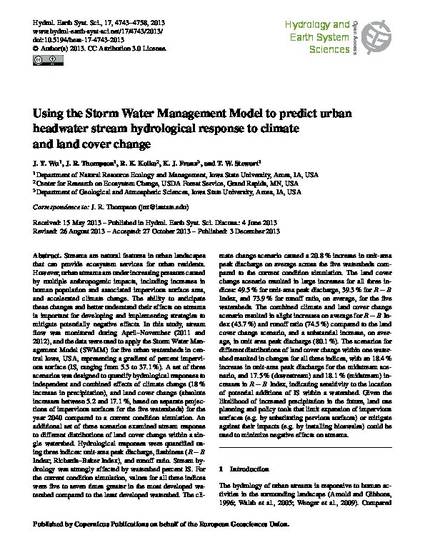
Streams are natural features in urban landscapes that can provide ecosystem services for urban residents. However, urban streams are under increasing pressure caused by multiple anthropogenic impacts, including increases in human population and associated impervious surface area, and accelerated climate change. The ability to anticipate these changes and better understand their effects on streams is important for developing and implementing strategies to mitigate potentially negative effects. In this study, stream flow was monitored during April-November (2011 and 2012), and the data were used to apply the Storm Water Management Model (SWMM) for five urban watersheds in central Iowa, USA, representing a gradient of percent impervious surface (IS, ranging from 5.3 to 37.1%). A set of three scenarios was designed to quantify hydrological responses to independent and combined effects of climate change (18% increase in precipitation), and land cover change (absolute increases between 5.2 and 17.1%, based on separate projections of impervious surfaces for the five watersheds) for the year 2040 compared to a current condition simulation. An additional set of three scenarios examined stream response to different distributions of land cover change within a single watershed. Hydrological responses were quantified using three indices: unit-area peak discharge, flashiness (R-B Index; Richards-Baker Index), and runoff ratio. Stream hydrology was strongly affected by watershed percent IS. For the current condition simulation, values for all three indices were five to seven times greater in the most developed watershed compared to the least developed watershed. The climate change scenario caused a 20.8% increase in unit-area peak discharge on average across the five watersheds compared to the current condition simulation. The land cover change scenario resulted in large increases for all three indices: 49.5% for unit-area peak discharge, 39.3% for R-B Index, and 73.9% for runoff ratio, on average, for the five watersheds. The combined climate and land cover change scenario resulted in slight increases on average for R-B Index (43.7%) and runoff ratio (74.5%) compared to the land cover change scenario, and a substantial increase, on average, in unit area peak discharge (80.1%). The scenarios for different distributions of land cover change within one watershed resulted in changes for all three indices, with an 18.4% increase in unit-area peak discharge for the midstream scenario, and 17.5% (downstream) and 18.1% (midstream) increases in R-B Index, indicating sensitivity to the location of potential additions of IS within a watershed. Given the likelihood of increased precipitation in the future, land use planning and policy tools that limit expansion of impervious surfaces (e.g. by substituting pervious surfaces) or mitigate against their impacts (e.g. by installing bioswales) could be used to minimize negative effects on streams.
Available at: http://works.bepress.com/timothy_stewart/16/

This article is from Hydrology and Earth System Sciences 17 (2013): 4743, doi:10.5194/hess-17-4743-2013.